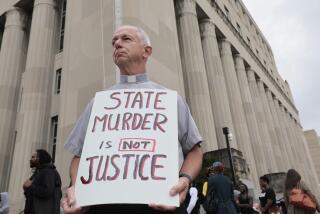Murder, the justice system and ‘Manifest Injustice’
For some criminal defense attorneys and journalists, the quest to find and exonerate an inmate wrongly convicted of murder is the white whale of their profession — endlessly pursued with a passion that borders on zeal.
In his deeply reported and briskly written new book, “Manifest Injustice: The True Story of a Convicted Murderer and the Lawyers Who Fought for His Freedom,” Pulitzer Prize-winning journalist-author Barry Siegel tells of one such quest that stretched over a decade.
If it were simply a story of virtue’s triumph over adversity, “Manifest Injustice” would be both important and highly readable. But — without providing spoiler information here — its denouement is more complex and its conclusions are more nuanced. Pity the reader who bails out early.
At the center of the twisting tale is Bill Macumber, model citizen, military veteran, super-dad and law-enforcement supporter who was arrested 12 years after the 1962 murder of a young couple who were snuggling in their car parked on a lover’s lane outside Scottsdale, Ariz. Convicted of two counts of first-degree murder, he was sentenced to life in prison without parole.
Late in the saga, a member of the Arizona state clemency board, a former state attorney general, called the Macumber case “one of the most extraordinary I have ever seen” with its tangled facts and puzzling questions.
Siegel’s careful, detailed reporting reveals a series of oddities and contradictions: a confession to the murder by a convicted killer that was not allowed as evidence; a supposed confession by Macumber given to his estranged wife, an employee of the sheriff’s department investigating the case; disputed ballistics and fingerprint evidence; and the lack of a motive or any prior behavior that could explain a double murder.
A young woman claimed to have been at the scene when the murders occurred. Her description of the gunman seemed to match that of the confessed killer, who died in prison. She knew facts that were never included in news stories. But then she recanted her story.
A picture of a palm print on the car of the two victims seemed, to the prosecution, to fit Macumber. Did Macumber’s wife, with access to the evidence because of her job, doctor the print to frame him, as he long claimed?
And then there’s Macumber. He became the most model of prisoners, establishing self-help programs for inmates, allowed to travel outside the prison without supervision because authorities trusted him not to flee. He is calm and articulate, his letters and journals compelling.
In 1998, more than two decades after his conviction, Macumber’s case came to the attention of the Arizona Justice Project through the persistence of a cousin who never stopped believing him.
Led by a veteran defense attorney and backed by the idealism and energy of law students at Arizona State University, the project takes on the toughest of cases: those in which innocence cannot be established by DNA evidence because none exists.
Among the many contradictions pointed out by Siegel, a former Los Angeles Times reporter and now a professor at UC Irvine, is this whopper: DNA has been used to free hundreds of prisoners, showing that the criminal justice system is deeply flawed. Yet the promise and hype surrounding the advanced technology may have made it more difficult for prisoners to win appeals in cases where no such evidence exists.
Rich Robertson, a reporter turned private detective, soon concluded that finding evidence in the Macumber case was “like doing archaeology.” Law enforcement documents had been scattered and lost; a “housecleaning” at the Maricopa County Superior Court “authorized the destruction of all evidence and exhibits in the Macumber case.”
Macumber’s life sentence made it even more difficult to reconstruct the facts of the original investigation. “Better if they’d sentenced Macumber to death,” Siegel writes. “At least then everything would have been preserved for the endless appeals.”
Although Macumber is at the center, some of the best parts of “Manifest Injustice” are Siegel’s mini-portraits of the lawyers and law students. The two top lawyers, both law professors, are studies in contradiction. The respectful tension between them drives much of the story:
“They revered each other, but Bob Bartels’s measured caution at times conflicted with Larry Hammond’s impetuous optimism. Where Hammond, far less skeptical, invariably wanted to run to court with a petition, Bartels often favored further investigation.”
After decades of experience, each had concluded that too often a criminal trial is not a search for truth but rather a clash of narratives:
“In constructing stories, lawyers recognize only the evidence consistent with their theory of the case. So do the police, the forensic experts, and the judges and — finally — jurors. Everyone sees what they want, sees what fits their particular take.”
“Manifest Injustice” has scenes that surpass any TV crime drama: Macumber’s reconciliation with one of his three sons; the mix of despair and enthusiasm of the defense team; the cliffhanging nature of various legal maneuvers.
In 2012, when Macumber was 77 and sick from old-age ailments made worse by years behind bars, his lawyers had a final shot at presenting his case.
As his book reaches its climax, Siegel notes that to Hammond, “Legal tactics often reminded him of a chess game.” If so, “Manifest Injustice” suggests it’s a game in which justice can get lost in the battle between contestants.
Manifest Injustice
The True Story of a Convicted Murderer and the Lawyers Who Fought for His Freedom
Barry Siegel
Henry Holt and Company: 400 pp., $28
More to Read
Sign up for our Book Club newsletter
Get the latest news, events and more from the Los Angeles Times Book Club, and help us get L.A. reading and talking.
You may occasionally receive promotional content from the Los Angeles Times.







